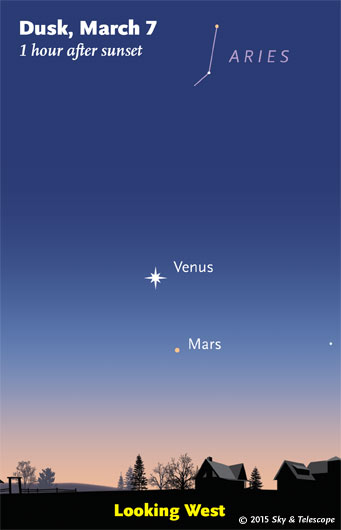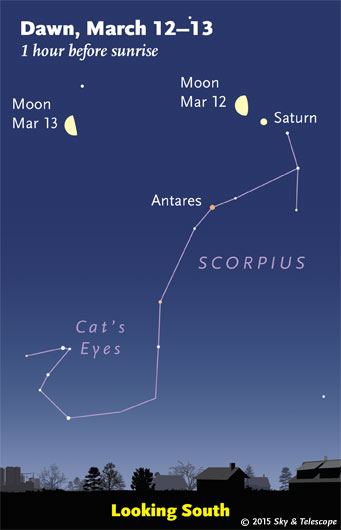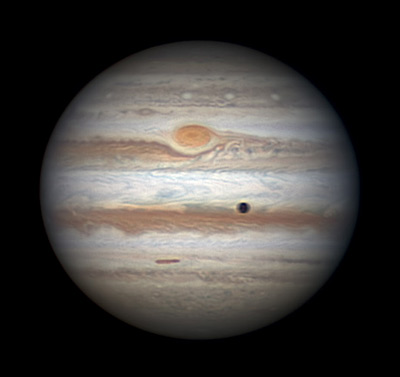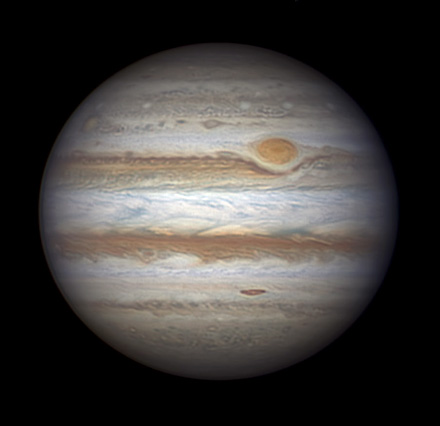Some daily sky sights among the ever-changing Moon, planets, and stars.

Friday, March 6
Venus and Mars in the western twilight have widened quite a bit — they're now 6° apart — following their conjunction two weeks ago. Look for faint Mars under Venus. The gap between them enlarges a little more each day.
As the stars come out at this time of year, look due south for Orion standing upright at his highest. As night deepens, dim Lepus, the Hare, emerges under his feet. Below Lepus is Columba, the Dove.
Saturday, March 7
Mutual event among Jupiter's moons. Telescope users can watch Europa occult (cross in front of) Io from 1:15 to 1:21 a.m. Sunday morning EST. The blend of the two dims by just 0.5 magnitude at mid-event. They're the pair of moons closest to Jupiter at the time. Then exactly one hour after the end of that event, Europa's shadow starts eclipsing Io for 6 minutes, dimming it by 0.8 magnitude at mid-eclipse.
Similar mutual events happen among Jupiter's moons through the rest of the month; see the March Sky & Telescope, page 53. If you're not in North America, here's where to get the whole list worldwide, sortable by visibility from your location. These "mutual event seasons" happen about every 6 years. The current one trails off later this spring.
Daylight-saving time begins at 2 a.m. Sunday morning for most of the U. S. and Canada. Clocks spring ahead one hour.
Sunday, March 8
Now that the Moon is gone from the early-evening sky, have another look for Comet Lovejoy! It's crossing Cassiopeia and still 6th magnitude, fading more slowly than predicted. Plan to go out right after dark. See article and finder chart: Comet Lovejoy Shines On.
Monday, March 9
Ganymede, Jupiter's biggest moon, enters onto Jupiter's face at 10:10 p.m. EDT and exits at 1:47 a.m. EDT. Its black shadow trails almost three hours behind, crossing Jupiter from 1:05 to 4:43 a.m. EDT. (Subtract 3 hours to get Pacific times; this event is more convenient for the West Coast.)
Tuesday, March 10
Jupiter this month forms a big, more-or-less equilateral triangle with Procyon and Pollux. Face southeast soon after dark, and Procyon is to Jupiter's right. Pollux is high above them.
Procyon is also part of the slightly larger Winter Triangle just to the west, also equilateral. Its other stars are orange Betelgeuse and bright Sirius below.
Wednesday, March 11
The eclipsing variable star Algol should be at minimum brightness, magnitude 3.4 instead of its usual 2.1, for a couple hours tonight centered on midnight EDT; 9 p.m. PDT. Algol takes several additional hours to fade and to rebrighten.

Before and during dawn Thursday morning the 12th, the waning Moon poses near Saturn, as shown here. Look for Antares below them.
Thursday, March 12
On Friday morning the 13th, the last-quarter Moon shines to the left of Saturn and the head of Scorpius before and during dawn.
Friday, March 13
You know the season is shifting. As the stars come out, the Big Dipper standing on its handle in the northeast is now as high as Cassiopeia standing on end in the northwest. The Dipper is rising into spring and summer, and Cas is descending from its high showing in fall and winter.
Saturday, March 14
On the traditional divide between the winter and spring sky is dim Cancer, marked this year by Jupiter. Wintry Gemini is to its west, and Leo of spring is to its east. Don't be too distracted by Jupiter; Cancer also hosts the Beehive Star Cluster, M44, in its middle. Look for it 6° to Jupiter's upper right after dark. That's about the width of a binocular's field of view.
Algol should be in mideclipse around 9 p.m. Eastern Daylight Time.
Want to become a better astronomer? Learn your way around the constellations. They're the key to locating everything fainter and deeper to hunt with binoculars or a telescope.
This is an outdoor nature hobby; for an easy-to-use constellation guide covering the whole evening sky, use the big monthly map in the center of each issue of Sky & Telescope, the essential guide to astronomy. Or download our free Getting Started in Astronomy booklet (which only has bimonthly maps).

Once you get a telescope, to put it to good use you'll need a detailed, large-scale sky atlas (set of charts). The standards are the little Pocket Sky Atlas, which shows stars to magnitude 7.6; the larger and deeper Sky Atlas 2000.0 (stars to magnitude 8.5); and once you know your way around, the even larger Uranometria 2000.0 (stars to magnitude 9.75). And read how to use sky charts with a telescope.
You'll also want a good deep-sky guidebook, such as Sue French's Deep-Sky Wonders collection (which includes its own charts), Sky Atlas 2000.0 Companion by Strong and Sinnott, the bigger Night Sky Observer's Guide by Kepple and Sanner, or the beloved if dated Burnham's Celestial Handbook.
Can a computerized telescope replace charts? Not for beginners, I don't think, and not on mounts and tripods that are less than top-quality mechanically (able to point with better than 0.2° repeatability, which means fairly heavy and expensive). As Terence Dickinson and Alan Dyer say in their Backyard Astronomer's Guide, "A full appreciation of the universe cannot come without developing the skills to find things in the sky and understanding how the sky works. This knowledge comes only by spending time under the stars with star maps in hand."
This Week's Planet Roundup


Mercury is sinking out of sight into the glare of sunrise.
Venus (magnitude –3.9) and Mars (less than 1% as bright at magnitude +1.3) are in the west during evening twilight. Look for Mars increasingly far below brilliant Venus.
Jupiter (magnitude –2.5, in Cancer) is already high in the east as the stars come out. It's highest in the south around 11 p.m. daylight-saving time.
It's been a month since Jupiter's opposition, but Jupiter is still 44 arcseconds wide in a telescope. Don't expect to see anywhere near the amount of detail with your eye that sophisticated digital stacking with a large amateur telescope can bring out, such as in the extraordinary images here!
Saturn (magnitude +0.4, at the head of Scorpius) rises around 1 a.m. daylight-saving time. It's highest in the south as dawn begins. Below or lower left of Saturn by 8° is orange Antares.
Look just ½° below Saturn in early dawn for Nu Scorpii, a showpiece double star for telescopes. Less than 2° to their right is Beta Scorpii, an even finer telescopic double.
Uranus (magnitude 5.8, in Pisces) is hiding in the background of Venus and Mars just after dark.
Neptune is out of sight behind the glare of the Sun.
All descriptions that relate to your horizon — including the words up, down, right, and left — are written for the world's mid-northern latitudes. Descriptions that also depend on longitude (mainly Moon positions) are for North America.
Eastern Standard Time (EST) is Universal Time (UT, UTC, or GMT) minus 5 hours. Eastern Daylight Time (EDT) is UT minus 4 hours.
“This adventure is made possible by generations of searchers strictly adhering to a simple set of rules. Test ideas by experiments and observations. Build on those ideas that pass the test. Reject the ones that fail. Follow the evidence wherever it leads, and question everything. Accept these terms, and the cosmos is yours.”
— Neil deGrasse Tyson, 2014.
 3
3
Comments
Tom Hoffelder
March 6, 2015 at 8:12 am
I'm a little confused (situation normal) by the mutual events magnitude changes, especially for the occultations. The magnitude change is based on the COMBINED magnitude of the two involved moons. For the Sunday morning event, that is listed as 4.6, but do we ever see that or the 0.5 drop? At opposition the magnitudes of Io and Europa are 5.0 and 5.3 (so a little less now?). Maybe when the moons get really close they appear as mag 4.6 and at mid eclipse they appear as mag 5.1 combined which is close to the individual magnitudes.
The eclipses seem a little clearer, maybe. Again the difference is based on the change of the combined magnitude. It seems that during the eclipse a change of 0.8 would drop Io from 5.0 to 5.8, but is that the same as dropping the combined magnitude from 4.6 to 5.4? If not, for eclipses it would be nice to know the delta m as the change in magnitude of the eclipsed moon.
You must be logged in to post a comment.
March 7, 2015 at 2:08 am
Hello, Very interesting articles but I live in the southern hemisphere in Australia, but all your articles relate to the northern hemisphere. How do I get information for us "down under"?
You must be logged in to post a comment.
RC Silk
March 13, 2015 at 4:58 pm
1) migrate northwards
2) this is a great opportunity for you to begin your own edition of "Beneath (or 'Down Under') the Sky and Telescope" magazine, focusing on articles relative to the Southern Hemisphere.
You must be logged in to post a comment.
You must be logged in to post a comment.